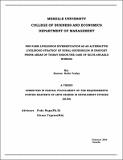| dc.description.abstract | The Ethiopian government has been putting more emphasis to the agriculture sector as a strategy to resolve the challenges in food security. However, crop and livestock production is no longer the only sources of rural households´ income. Solely depending on agriculture is unlikely to improve food security because of the increase in population pressure and recurrent drought. Farmers themselves have realized that farming is not enough for meeting their consumption and cash income needs. Thus, many policy makers have an intense interest in promoting income-generating activities via non-farm livelihood diversification at household level. This study was conducted in drought prone area of Tigray region with particular reference to Kilte-Awlaelo Woreda. It attempts to identify how diversification is perceived and the type of non-farm activities, explore the major factors that affect non-farm income and diversification and constraints confronting rural household from diversifying, and assess the implication of adopting non-farm livelihood as alternative livelihood strategy. Both the quantitative and qualitative research methods were employed. As part of quantitative and qualitative research methods, primary data were collected by means of household survey questionnaire and focus group discussions respectively. Descriptive analysis and linear regression model were used as tools of analysis. In the study area, a number of non-farm activities have been identified from which sand and stone quarrying, is the major one followed by livestock trading, pottery making and petty trading etc. Taking wealth status in to account, 35.3 % of the poor, 25% of the medium and 17.6 % of the better of wealth category have participated in non-farm activities. Implying that the greatest extent of diversification is among the poor and medium households, however, diversification among the better off group is less. The research result from the econometrics analysis indicates that sex of the household head, family size, credit access, livestock holding, oxen ownership, land holding, farm income have significant influence in non farm income and diversification in the study area. Insufficient start up capital, absence of local infrastructure services, and lack of appropriate entrepreneurial skills are the major constraints that prevent households from participating in non-farm livelihood diversification. Therefore, rural development policy should give more emphasis to the non-farm sector to diversify the sources of rural households income to supplement their farm income by improving access to credit, schooling, infrastructures and marketing as part of poverty reduction strategy. | en_GB |


